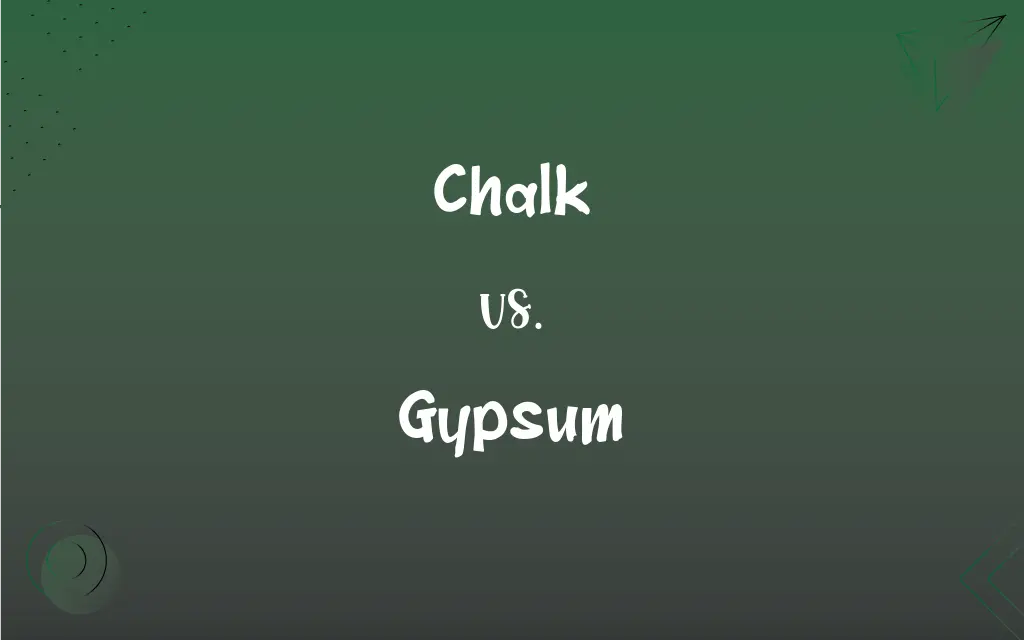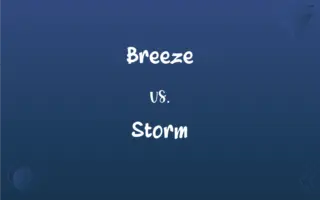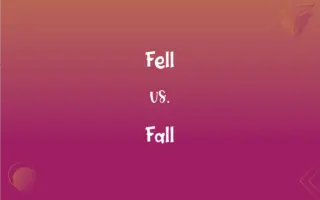Chalk vs. Gypsum: What's the Difference?
Edited by Aimie Carlson || By Janet White || Updated on October 19, 2023
"Chalk is a soft, white, porous sedimentary rock made of calcium carbonate, while gypsum is a mineral composed of calcium sulfate dihydrate, widely used in building."

Key Differences
Chalk, primarily composed of calcite, is a form of limestone deposited by the mineral remains of marine organisms. Gypsum, in contrast, is a soft sulfate mineral composed of calcium sulfate dihydrate, often found in sedimentary rock formations and on the surfaces of dry, ancient seabeds.
Chalk has been widely used in agriculture to adjust soil pH levels and in classrooms worldwide for writing on blackboards, showing its versatile nature. Gypsum, known for its versatility in the construction industry, is used to make products like drywall and plaster of Paris, showcasing its wide-ranging applicability.
In chalk, the calcite originates from the shells of microscopic plankton called coccolithophores, indicating a biological origin. Gypsum, however, often forms due to the evaporation of water in arid conditions, making it a more commonly found mineral in desert regions.
Chalk, owing to its porous nature and light color, has also found its place in sports, for marking fields, or in rock climbing for grip. Gypsum, due to its fire-resistant qualities, is crucial in home construction, adding safety to building structures.
While both chalk and gypsum are essential minerals found on Earth, chalk is specifically impactful in areas like education, sports, and small-scale farming. Gypsum, with its applications in construction, agriculture, and art, holds a broader spectrum of utility.
ADVERTISEMENT
Comparison Chart
Composition
Calcium carbonate (CaCO3)
Calcium sulfate dihydrate (CaSO4·2H2O)
Origin
Marine organisms' mineral remains
Evaporation in sedimentary layers
Uses
Agriculture, education, sports
Construction, agriculture, art
Physical Property
Soft, porous, white
Soft, can be transparent or translucent
Formation
Biological sedimentation
Evaporation or hydrothermal processes
ADVERTISEMENT
Chalk and Gypsum Definitions
Chalk
A stick of this rock or a similar substance used for writing or drawing.
She picked up a piece of chalk and wrote the equation on the blackboard.
Gypsum
A soft sulfate mineral composed of calcium sulfate dihydrate.
The cave's walls were lined with crystals of gypsum.
Chalk
A substance used for drawing or writing, especially in the past on blackboards.
The teacher distributed chalk to students for the art project.
Gypsum
A mineral used in crystal form for sculptures and as a fertilizer.
The artist carved intricate shapes out of gypsum.
Chalk
Ground calcium carbonate used to make the soil more alkaline.
Farmers use chalk to improve soil quality for their crops.
Gypsum
A widespread colorless, white, or yellowish mineral used in making plaster of Paris, drywall, and cements.
They mined gypsum to use in construction.
Chalk
A soft compact calcite, CaCO3, with varying amounts of silica, quartz, feldspar, or other mineral impurities, generally gray-white or yellow-white and derived chiefly from fossil seashells.
Gypsum
A substance used in construction that offers fire resistance.
For safety reasons, gypsum is a standard material in home interiors.
Chalk
A piece of chalk or chalklike substance in crayon form, used for marking on a blackboard or other surface.
Gypsum
A rock or mineral used to correct compacted soil or to remove grease from a surface.
Farmers apply gypsum to condition the soil for agricultural use.
Chalk
(Games) A small cube of chalk used in rubbing the tip of a billiard or pool cue to increase its friction with the cue ball.
Gypsum
A widespread colorless, white, or yellowish mineral, CaSO4·2H2O, used in the manufacture of plaster of Paris, various plaster products, and fertilizers.
Chalk
A mark made with chalk.
Gypsum
A mineral consisting of hydrated calcium sulphate. When calcinated, it forms plaster of Paris.
Chalk
Chiefly British A score or tally.
Gypsum
A mineral consisting of the hydrous sulphate of lime (calcium). When calcined, it forms plaster of Paris. Selenite is a transparent, crystalline variety; alabaster, a fine, white, massive variety.
Chalk
To mark, draw, or write with chalk
Chalked my name on the blackboard.
Gypsum
A common white or colorless mineral (hydrated calcium sulphate) used to make cements and plasters (especially plaster of Paris)
Chalk
To rub or cover with chalk, as the tip of a billiard cue.
Chalk
To make pale; whiten.
Chalk
To treat (soil, for example) with chalk.
Chalk
(uncountable) A soft, white, powdery limestone (calcium carbonate, CaCO3).
Chalk cliffs are not recommended for climbing
Chalk
(countable) A piece of chalk, or nowadays processed compressed gypsum (calcium sulfate, CaSO4), that is used for drawing and for writing on a blackboard (chalkboard).
The chalk used to write on the blackboard makes a squeaky sound
Chalk
Tailor's chalk.
Chalk
A white powdery substance used to prevent hands slipping from holds when climbing, or losing grip in weight-lifting or gymnastics, sometimes but not always limestone-chalk, often magnesium carbonate (MgCO3).
When working out your next move, it's a good idea to get some more chalk from the bag
Chalk
A platoon-sized group of airborne soldiers.
Chalk
The favorite in a sporting event.
Chalk
The prediction that there will be no upsets, and the favored competitor will win.
Chalk
To apply chalk to anything, such as the tip of a billiard cue.
Chalk your hands before climbing
Chalk
To record something, as on a blackboard, using chalk.
Chalk
To use powdered chalk to mark the lines on a playing field.
Chalk
(figuratively) To record a score or event, as if on a chalkboard.
Chalk
To manure (land) with chalk.
Chalk
To make white, as if with chalk; to make pale; to bleach.
Chalk
A soft, earthy substance, of a white, grayish, or yellowish white color, consisting of calcium carbonate, and having the same composition as common limestone.
Chalk
Finely prepared chalk, used as a drawing implement; also, by extension, a compound, as of clay and black lead, or the like, used in the same manner. See Crayon.
Chalk
To rub or mark with chalk.
Chalk
To manure with chalk, as land.
Chalk
To make white, as with chalk; to make pale; to bleach.
Let a bleak paleness chalk the door.
Chalk
A soft whitish calcite
Chalk
A pure flat white with little reflectance
Chalk
Amphetamine used in the form of a crystalline hydrochloride; used as a stimulant to the nervous system and as an appetite suppressant
Chalk
A piece of chalk (or similar substance) used for writing on blackboards or other surfaces
Chalk
Write, draw, or trace with chalk
Chalk
A soft, white, porous sedimentary rock.
The cliffs of Dover are made of chalk.
FAQs
What is chalk commonly used for?
Chalk is often used in education for writing, in sports for grip, and in agriculture to reduce soil acidity.
Can chalk be used for art?
Yes, chalk is commonly used for street art and drawing on various surfaces due to its ease of use and bright colors.
Why is chalk used on sports fields?
Chalk provides highly visible marking on grass that is easy to apply and remove, ideal for marking play areas.
How does gypsum benefit the soil?
Gypsum improves soil structure, drainage, and aeration, and provides essential nutrients like calcium and sulfur.
Is gypsum harmful to humans?
Gypsum is generally safe; however, inhaling gypsum dust can irritate the respiratory system, and ingestion can cause digestive discomfort.
What products are made from gypsum?
Products like drywall, plaster of Paris, cement, and certain types of plaster are made from gypsum.
Where is gypsum most commonly found?
Gypsum is often found in dry, arid areas and is a common mineral in sedimentary rock formations.
Why is gypsum used in construction?
Gypsum is fire-resistant, easy to shape, and lightweight, making it ideal for interior walls and ceilings.
Is all chalk white?
No, chalk for drawing or writing is often dyed different colors for visibility and artistic purposes.
Can gypsum be used for sculptures?
Yes, gypsum is often used in its crystal form for sculptures and other artistic applications.
Is chalk still used in classrooms today?
Yes, though many classrooms have switched to whiteboards, chalk is still used in various educational settings.
Are there alternatives to using chalk in agriculture?
Yes, lime is a common alternative used to adjust soil pH.
What's the difference between chalk and chalkboard chalk?
They're the same; however, "chalkboard chalk" specifically refers to chalk used for writing on chalkboards.
What are the environmental impacts of chalk use?
Chalk is natural and biodegradable, posing minimal environmental impact. However, mining practices for chalk must be environmentally responsible.
How is gypsum mined?
Gypsum is usually mined through open-pit mining or quarrying, where it's extracted from large deposits.
Can chalk be used for antacid purposes?
Chalk (calcium carbonate) can act as an antacid; however, it's advisable to use pharmaceutical-grade products for this purpose.
Is gypsum a renewable resource?
Gypsum is considered non-renewable, but it's abundant and recyclable, making it sustainable for continuous use.
Is gypsum environmentally friendly?
Gypsum products are sustainable and recyclable, but mining operations must take environmental precautions to minimize impact.
Can gypsum boards be used in high humidity areas?
Yes, there are specific moisture-resistant gypsum boards for use in high humidity areas.
Can you eat chalk?
Chalk isn't toxic but isn't meant for consumption. Eating chalk can cause digestive issues and isn't nutritionally beneficial.
About Author
Written by
Janet WhiteJanet White has been an esteemed writer and blogger for Difference Wiki. Holding a Master's degree in Science and Medical Journalism from the prestigious Boston University, she has consistently demonstrated her expertise and passion for her field. When she's not immersed in her work, Janet relishes her time exercising, delving into a good book, and cherishing moments with friends and family.
Edited by
Aimie CarlsonAimie Carlson, holding a master's degree in English literature, is a fervent English language enthusiast. She lends her writing talents to Difference Wiki, a prominent website that specializes in comparisons, offering readers insightful analyses that both captivate and inform.































































